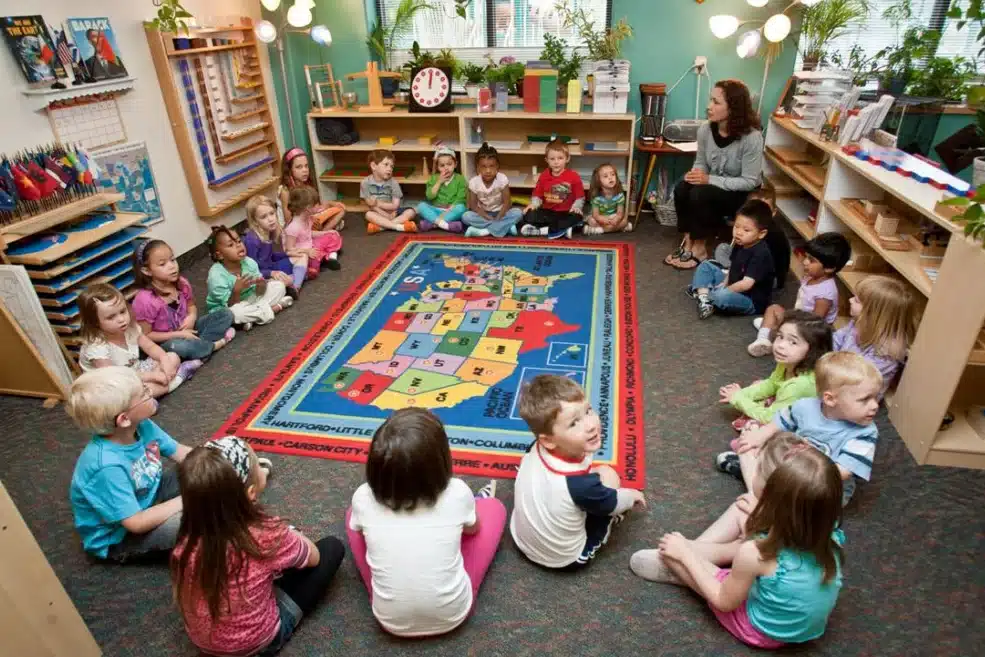
The first three years of a child’s life lay the foundation for their future Montessori Early Childhood development. Maria Montessori called this period the “spiritual embyo,” which refers to a child’s “absorbent mind.” This mind has formed through experiences, emotions, images, language, and culture. These life experiences form the brain’s networks of neurons, which eventually shape their personality. In addition, Montessori emphasizes the importance of being hands-on and encouraging children to explore their environment.
Montessori Method Promotes Independence & Self-Regulation
A Montessori classroom encourages a child to take initiative in exploring and learning. With freedom to choose, children are free to engage in activities that meet their needs and interests. A Montessori classroom has three different age groups, with a multi-age classroom that re-creates the family unit. A multi-age classroom has designed to foster respect, love, and peaceful conflict resolution. The children are free to explore and choose the materials they wish to use.
The Montessori method also promotes independence and self-regulation. A multi-age classroom allows children to develop self-regulation and education. Children are also learn to respect one another and practice mutual respect. Teachers model loving kindness, respect, and cooperation. They believe that peaceful conflict resolution is essential for a Montessori Early Childhood Development. The multi-age environment is a valuable component of the Montessori method. The ideal classroom has designed to support independence and a child’s growth as they learn to interact with others.
School Benefit from a Prepared, Tidy, & Simple Environment
Children who attend a Montessori school benefit from a prepared, tidy, and simple environment. A typical classroom will feature mixed-age children ages three and four. This ensures a safe and secure environment. In a Montessori classroom, children engage with materials individually, in pairs, and in small groups for about 3 hours each day. While children guided by the teacher, they are free to choose where they want to work, whom to interact with, and how long they want to play.
To understand the Montessori Early Childhood Development method, parents must visit the school. Most Montessori schools will allow visitors to observe the classroom. The observer sits in a chair in the middle of the room and observes the entire classroom. Observations usually last from thirty minutes to an hour. It is important to visit the school several times. Once a parent feels comfortable with the program, it has likely to a great fit for their child.
Designed to Encourage Self-Education & Self-Regulation
The Montessori environment promotes self-regulation and education in children. The environment has designed to encourage self-education and self-regulation. Typically, students attend a Montessori classroom for three years. If a child is ready, the teacher will teach them how to treat each other in a way that encourages them to follow rules. It is essential to establish positive relationships between siblings and adults. The environment should be free of conflict. The goal of every child is to learn about the principles of cooperation and respect.
Children who are ready to start kindergarten are eager to explore new things. The Montessori curriculum follows a three-year sequence. The curriculum is structured so that the preschoolers can develop self-control and patience. The preschoolers are given opportunities to choose from many different activities and materials. They can work independently or play with a partner. As a result, the environment encourages independence and helps children develop social skills.
Ability to Make Independent Ddecisions
A Montessori environment is child-centered, and children can easily feel at home within the environment. The Montessori method also develops a child’s independence. Because each activity is designed to teach the child how to make a living, the Montessori environment fosters independence and the ability to make independent decisions. This approach can be effective in helping children adjust to the realities of life in adulthood. While the Montessori method has many advantages, it is not for everyone.
Observations are essential for a child’s development. While attending a Montessori school, parents should observe the children’s classroom. Most Montessori schools have a policy of welcoming observers. The observers will sit in a chair and observe the entire room. Typically, observations last for 30 minutes to an hour, but the process of observation is crucial to getting a sense of how the children learn. Some may learn concepts faster in a Montessori environment than in a conventional classroom.

